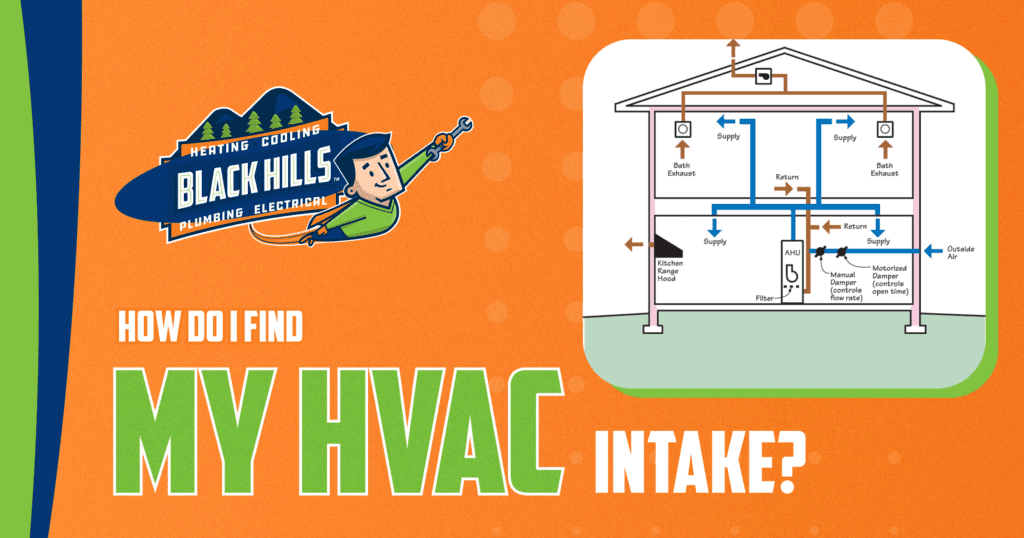Your HVAC system contains numerous vents that blow hot or cold air into your rooms, distributing the air throughout your home. But where does your HVAC get the air in the first place? Your HVAC system must get the air either from inside or outside the home.
All HVAC systems have at least one return air supply vent to take in air from inside, condition it, and circulate it back around your house. Return vents are a good idea because, in winter, it makes more sense to warm up moderately warm air rather than using all the energy it would take to warm up really cold outside air. The same goes for cool air during the summer.
Your HVAC system may also need an intake vent to gather air from outside. This guide will discuss what a furnace intake vent is, what it looks like, where to find it, and how to maintain it.
What Is an HVAC Intake Vent?
A furnace intake vent is how your gas furnace gathers air to be used in combustion. The natural gas must be lit on fire to produce heat. That fire requires oxygen for the combustion process to work. The oxygen must come either from the room the furnace is in or from outside.
A furnace may gather air from the room it is in for combustion. This can be common for furnaces in basements or crawl spaces. When the room is large enough, with few obstructions, furnaces can draw in air for their combustion. The intake vent would take the form of a grill or slot on the front of the furnace.
However, if your furnace is in a smaller room, garage, closet, laundry room, or other closed-off space, there will not be enough oxygen or air for it to draw in for efficient combustion. When there is not enough free air to draw it, it must be drawn in from outside, which is where a fresh air intake vent comes into play.
Furnace Fresh Air Intake
This device draws fresh air in from the outside and brings it to the furnace. A fresh air intake vent is required for all furnaces in enclosed spaces, as well as for several other circumstances.
For example, it is against building codes for furnaces to draw air from kitchens or bathrooms for combustion. There could be dangerous oils, sprays, or chemicals in the air that might be drawn in that could cause serious problems.
Another example is when a furnace has a 90 percent or greater efficiency. These types of furnaces require fresh air to operate at their 90 percent peak efficiency. When only drawing in the surrounding air, a 90 percent efficiency furnace will operate like an 80 percent efficiency furnace or even lower.
Why Have a Fresh Air Intake?
There are several reasons why it’s a good idea to have a fresh air intake and pull fresh air from outside. The first reason is that fresh air is just that—fresh. Continually recycled air gets stagnant and musty, and we want our HVAC system to bring in fresh air to improve indoor air quality.
The next reason is that air is vented out from several locations in your home and that air needs to be replaced. Air is vented from your bathroom fans, your stove range (if set up properly), your water heater, your dryer, and your furnace. All that air is leaving your home, and it needs to be replaced in order to prevent forming a vacuum.
You may have felt the effects of an indoor air vacuum when a door mysteriously slams shut. An air vacuum could cause air to be drawn from unconditioned spaces like your attic, crawl space, or basement, which can contaminate your indoor air quality.
Finally, many furnaces run more efficiently with a fresh air intake drawing in fresh air to aid in cleaner combustion. The more efficient you are with your natural gas, the lower your energy bills will be.
The HVAC fresh air intake supplies fresh air to your HVAC from outside your house. It delivers clean air and oxygen that enable the furnace to run efficiently and prevent the system from drawing air in from unconditioned areas, which can reduce air quality. You, or an HVAC technician, can install a fresh air intake vent if your system doesn’t have one.
How Do I Identify a Fresh Air Intake vs. an Exhaust Vent?
What does a furnace’s fresh air intake look like? You first need to know what you’re looking for. An exhaust vent has a flap or cover. These fixtures vent used air from kitchen range hoods, dryer vents, and bathroom fan escapes.
A fresh air intake contains a screen where cool, fresh air can enter. Once you find it, check for a feeling of suction when the furnace is on (it feels like a breeze pulling into the vent). This means that it is drawing air into the system.
Sometimes, an exhaust vent and intake vent are combined in the same location, with two PVC pipes poking out of the side of the house. The exhaust vent faces up, and the intake faces down.
Where Is My Fresh Air Intake Vent?
You may wonder where your HVAC intake is so you can properly maintain it and make sure your fresh air intake is unblocked. Oftentimes, the intake is on the side of the house. It can be in the form of a hood on an exterior wall. Look for a gray vent hood or a white or black plastic PVC pipe.
The fresh air intake leads to a duct that draws air into a vent near the furnace. It’s often required in the parts of the home where a gas appliance is installed, except for the garage. In most cases, you’ll need an intake for a gas heater, gas water heater, or gas dryer.
To find a fresh air intake, look for a grilled vent near a gas appliance. The vent may be out in the open, but it can also be installed behind the appliance or a door. If you can’t find it right away, look around and behind the furnace and check for an access panel.
The vent should not be blocked both inside and outside. Occasionally, you may want to close the fresh air intake vent in the event of heavy air pollution or due to heavy smoke in the air from a fire.
A screen on the outside prevents pests such as mice from entering and debris, snow, and ice from blocking the vent.
How to Maintain Your HVAC Intake Vents
It’s essential your intake vents are maintained and fully functioning. Otherwise, carbon dioxide and carbon monoxide (CO) can build up in your home. To avoid problems, follow these steps to care for these vents:
- Check for signs of CO leaks, including a yellow or flickering flame, rust on the vent pipe, and moisture on windows or walls.
- Clean the filters inside the fresh air intake.
- Replace the HVAC filter every 30 days.
- Make sure no materials or objects are covering the vent.
Also, be alert for signs of a backdraft. If moisture is condensing on windows, there’s rust on the grillwork in front of the furnace, or there’s hot air around the exhaust vent, a backdraft may be occurring. It’s a common sign of an unbalanced airflow. Ghosting, created by soot on walls, is another sign of a ventilation problem. Contact a professional when anything doesn’t seem right with your furnace.
Whether you need help with an HVAC intake or suspect there’s a problem with your furnace, Black Hills is here to help. We restore the heat and maintain HVAC systems for homeowners throughout the Olympia, Washington, area. To request heating maintenance or repair, schedule service online or call 888-619-0086.

